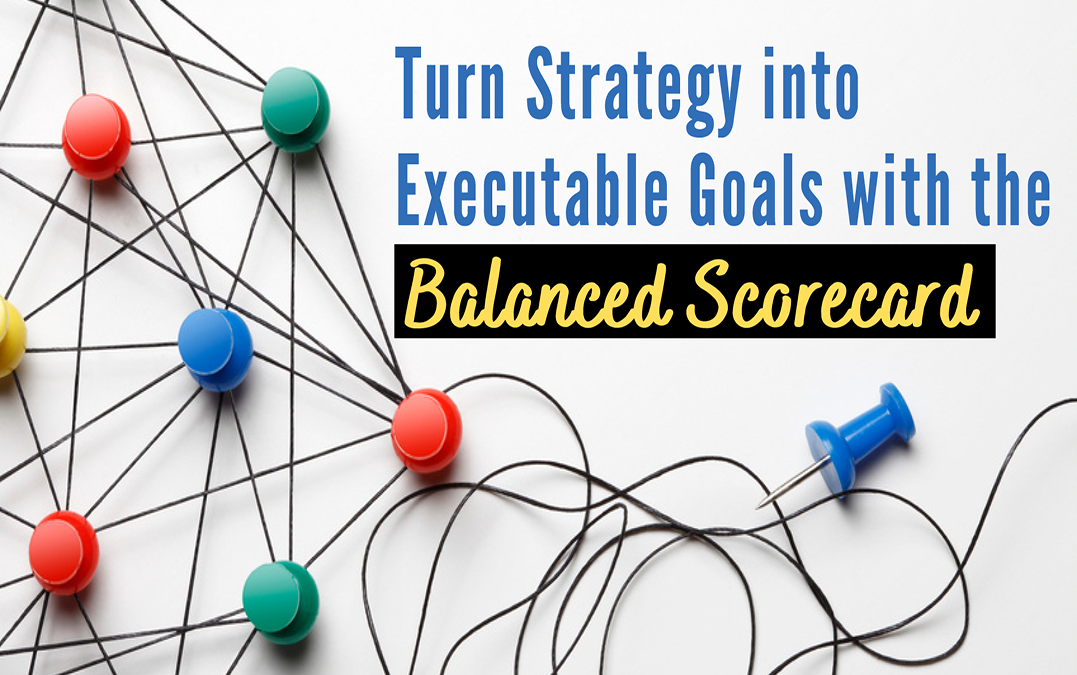
Strategy Execution
This is the time of the year when most organizations go into strategic planning mode. Senior executives gather for an annual planning summit. They look at external factors such as economic, competitor, and market data. They compare the strengths and weaknesses of their organizations with external opportunities and threats. They make decisions about what adjustments to make to services or products, how to reach new markets, and ways to generate higher profits.
Then what?
Unfortunately, most strategic plans sit in a 3-ring binder on a shelf collecting dust, or get saved in a digital file on one person’s hard drive, until it’s time to work on next year’s plan. It’s not much more than a theory, really. The sooner you can connect your strategic objectives with employee goals and rewards, the better chance you have of turning that theory into reality.
Here are three proven ways to move from strategic planning to strategy execution:
Break it down.
Many strategic plans focus primarily on financial metrics. Most employees don’t connect on a day to day basis with metrics like operating margins, cost of goods sold, and net profit. They don’t see how making a decision about how to handle a customer leads to achieving a desired profit margin. And when employees do get to see key performance metrics, the gap between when their performance occurred and the metrics is far too great to have any real meaning.
What kinds of metrics help people connect? Things like improving customer satisfaction, speeding up response times, reducing waste – just about anything that ties directly to the tasks they perform on a daily basis. When employees can see what winning looks like in ways they can relate to, they make better decisions in support of the plan.
Monitor progress.
Throw out the old paradigm of the annual performance review. That pattern traditionally goes like this: set goals, file goals, pull goals out after 12 months, beat employee about the head for not achieving goals. Instead, change the annual performance review process to one of continuous review and adjustment throughout the year. Why? You don’t want to save up negative feedback until the employee fails. Employee failure means organizational failure.
Link performance to rewards.
Employees should feel that when the organization has been successful, they share in the rewards. Conversely, when the organization has been unsuccessful, they should feel some of the pain. Incentive and reward systems should link directly to organizational and individual performance. Don’t be afraid to move all employee performance reviews to coincide with the release of annual performance results.
Strategy execution happens with true goal alignment from top to bottom, regular monitoring of progress, and linking individual incentives with organizational performance. Help your employees move from obliged to engaged to turn your strategy into reality.
Here’s a short parable to summarize the importance of true goal alignment:
There once was a Pharaoh who went out to inspect the progress of two pyramids. The first pyramid was a mess! The blocks were uneven, the ramps were unstable, oxen were milling about… The Pharaoh stopped a nearby worker and asked, “What is your job?” The worker replied, “I move stones from this pile to that pile all day.” At the next pyramid, the Pharaoh saw much greater progress. The blocks fit together perfectly. Teams of oxen were moving evenly up the ramps. This pyramid was really taking shape. When the Pharaoh asked a worker, “What is your job?” the worker replied, “I am building a pyramid!”
Question: How deep into your org chart do employees connect with the organization’s strategic goals?
Bonus! Download our simple, FREE strategic planning template here – a framework to help you measure organizational performance beyond key financial metrics.
Driven by the premise that excellence is the result of aligning people, purpose and performance, Center for Executive Excellence facilitates training in leading self, leading teams and leading organizations. To learn more, subscribe to receive CEE News!

Strategy Execution
Not long ago, I was asked by one of my clients if I could help her company with strategic planning. My answer was, “Yes and no.”
Like many of today’s organizations, this team was already suffering from initiative overload. Without a system for tracking business critical and mission critical goals, their strategic plan was doomed to fail. I explained that, “Yes, I would be happy to help your team create a strategic plan, but only if I can also help them put a system in place to help them execute that strategy.”
This is the season of the year where many of us are busy working on strategic plans. For some, those plans get shelved in favor of jumbled priorities and unfinished initiatives. For others, the goals that come out of the plans get added to the already impossibly long list of projects our overloaded teams are already working on. Either way, if we don’t have a process to turn our most important goals into an executable strategy, our plans can be pronounced dead on arrival.
Don’t let this happen to your organization. Instead, track your strategic goals with a performance management system like a Balanced Scorecard. First developed by Robert Kaplan and David Norton in the late 1990’s, today’s Balanced Scorecard platforms help organizations of all sizes and in every industry turn strategy in executable goals in four important ways:
- Communicate the business critical and mission critical goals the organization is trying to accomplish.
- Align the day-to-day work that everyone is doing with strategic goals.
- Prioritize projects, products, and services.
- Measure and monitor progress toward strategic targets.
The system connects the dots between big picture strategy, operational goals, and key performance metrics. I have my favorite balanced scorecard platforms, but one-size does not fit all. Check out this site for options that may work for your organization, and ensure that your strategic plans get executed in 2022!
Question: What is your organization doing to manage initiative overload?
Bonus! Download our simple, FREE strategic planning template here – a framework to help you measure organizational performance beyond key financial metrics.

Emerging Leaders, Leadership
By: Sheri Nasim, President & CEO
I once worked for a CEO who challenged me to write my own job description. We’d been working together for a couple of years, and I’d met some pretty big goals that he’d set out for me. When I told my husband about the CEO’s invitation to write my own job description, my husband said,
“Why don’t you make it 25% about what you’re already comfortable with and 75% what you’ve never done before?”
After getting over my initial annoyance at my husband’s advice, I decided to go for it. I wrote a job description that would be my dream position at the company then shared it with the CEO. He thanked me for putting in the effort and asked for some time to think about it. A few days later, he handed my job description back to me across his desk. Not only had he accepted the role that I’d had asked for, but he added another significant amount of responsibility to it.
Quite honestly, it took a full year for me to completely understand what the new role meant in practice. But, the CEO patiently allowed me to grow into it and make it my own. A few years in, I’d fundamentally changed how the management team took responsibility both for strategy execution, budgeting, and accountability for meeting financial results. In the process, I watched our management team grow its collective business acumen and work cross-functionally to deliver results that exceeded our strategic goals. That was one of the greatest growth opportunities I’ve had in my career.
I share this story because this is the kind of imposter syndrome that I wish for my clients, my colleagues, and for you as readers of this message. I want to hear that you’ve been given so much responsibility – coupled with an equal amount of psychological safety – that you question whether you’re really up for the challenge. I want to hear that you’re excited to be part of something bigger than yourself and stretched beyond anything you’ve ever accomplished before. I want you to test your assumptions, double check your math, and have both a sense of excitement and fear.
If you’ve been given an opportunity to do something that’s significantly greater than anything else you’ve ever done before, don’t gaslight yourself into thinking that you don’t have the ability to deliver. Growth begins where your comfort zone ends.
Question: What percentage of your week are you really challenged?





